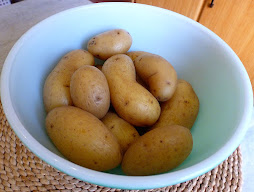A terrine is a terra cotta, faïence, or earthenware baking dish. By a figure of speech called "metonymy" the terrine is also the food baked in such a dish. So pâté and terrine are synonyms on one level. The day before yesterday I made a terrine de campagne, which is pâté de campagne baked in a terrine. You can see it in the photos in this post. This is a very simple recipe and doesn't contain anything like liver or tongue or any other animal organs. That might make it more appealing to people who don't relish the idea of eating organ meat (sometime called "variety meats" in America and known as "offal" in other countries).
The meat in this terrine is a mixture of pork and turkey. Or maybe it was veal. I'm not sure because I had two meat patties in the freezer that we had planned to eat on buns as hamburgers. I really don't remember whether they were ground turkey or ground veal. They weighed about 300 grams (10 oz.). I combined them with 700 grams (25 oz.) of pork tenderloin (all weights are approximate), most of which I also ran through the meat grinder, except for a small portion that I just cut into little cubes and mixed in with the ground ("minced") meats. I could have put in cubes of chicken, turkey, or veal but I used the pork tenderloin (called filet mignon in French) instead. I also added in some pecans (pistachios or walnuts would be good).
What binds this kind of "meat loaf" together is egg — in this case three eggs, beaten. What gives it good flavor is onion, garlic, herbs (thyme, parsley, bay leaves, etc.), spices (cloves, nutmeg, etc.) wine (or cognac, or whiskey), salt, and pepper. If the mixture seems a little bit too liquid, you can add some bread crumbs to it. I did add some. I didn't take any photos while I was putting the pain de viande mixture together (pain means "bread" but also means "loaf").
As with meat loaf, you can eat it hot (with gravy or tomato sauce), warm, or cold (in a sandwich). Cut into cubes, it could replace meatballs in spaghetti sauce. We just ate it for lunch with a salad, good bread, and some pickled gherkins (
cornichons). I think the next time I make this kind of
terrine I'll add some chicken or duck liver to the mixture for texture...
Here's a link to a recipe in French.


















































